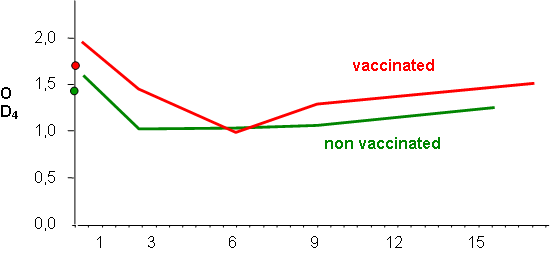Basic preventative measures of management should be included in the control of the disease, such as adequate temperature control of the barns, a complete all-in all-out hygiene and disinfection, and the avoidance of any mixing of animals from distinct sanitary origins. Other available tools for the control of Glässer’s disease are antimicrobial therapy and vaccination. When an outbreak appears, antimicrobial treatment can be efficient, especially if the treatment is carried out early, in the first moments of the infection. Normally a collective medication of the affected group is carried out through the drinking water or feed. It is vital to make sure that the animals take the adequate dose of antibiotics, so animals that show the most serious signs of disease, and therefore do not eat or drink like the rest, must be treated individually through parenteral via. One aspect to be kept in mind is the existence of a high percentage of H. parasuis strains which are resistant or multi-resistant to antimicrobials. For this reason it is always advisable for the laboratory to determine the antibiotic which is effective against the causal strain of the outbreak.
Antimicrobial resistance (%)
| Antibiotic |
H. parasuis isolates (Spain)
|
| Ampicillin |
57
|
| Ceftiofur |
7
|
| Enrofloxacin |
20
|
| Erythromycin |
40
|
| Florfenicol |
0
|
| Gentamicin |
27
|
| Neomicin |
33
|
| Oxitetraciclin |
40
|
| Penicillin |
60
|
| Spectinomycin |
23
|
| Tiamulin |
40
|
| Tilmicosin |
40
|
| Trimethoprim-sulphamide |
53
|
| Fuente: de la Fuente y col. 2007. Veterinary Microbiology 120:184-191. | |
Alternatively we should try to ensure that the animals have protective antibodies against H. parasuis, in order to prevent the appearance of the pathologies associated with this bacteria. Preventative measures have the additional advantage of allowing the reduction of the use of antibiotics. Theoretically several alternatives could be put into action to prevent the existence of unprotected animals: increasing the age of weaning, vaccination or artificially colonising the animals. Increasing the age of weaning, which increases the probability of the piglets being correctly colonised and therefore being capable of producing their own immune response against H. parasuis, has a very limited use due to the need of maintaining the profitability of the herd. Vaccination, on the other hand, is a viable alternative. The vaccines that are currently on the market are bacterines, that is to say, dead bacteria. As this type of preparation produces a protection which is dependent on serotype (see chapter “Immunity and serotype”), the most used strategy by companies has been the inclusion in their vaccines of the strains which belong to the most prevalent serotypes and which, to a certain extent, proportion cross-protection with other unrelated serotypes. These vaccines can be applied either in piglets or in mothers. Vaccination of mothers guarantees an increase in the level of antibodies that pass to the piglets, while vaccination of piglets, although it is more laborious, proportions a longer lasting immunity. Finally, positive results have been obtained experimentally when piglets were artificially inoculated via nasal, while they are protected by the maternal immunity, to colonise them with the virulent strain that had produced the disease on the farm. The biggest problem for this “artificial colonisation” with virulent strains is the introduction or maintenance on our farm of strains with pathogenic capacity, as it supposes an increased risk of Glässer’s disease appearing. The alternative would be to colonise with non-virulent strains, but this idea has yet to be tested.

Fig. 1. IgG levels in serum of piglets born from vaccinated and non vaccinated sows against Haemophilus parasuis.
Circles in the vertical axis show the IgG levels of sows (vaccinated:red; non vaccinated: green).
On the other hand, diverse current studies are concentrating on the identification of virulence factors of H. parasuis that could be good candidates to be included in future vaccines.




